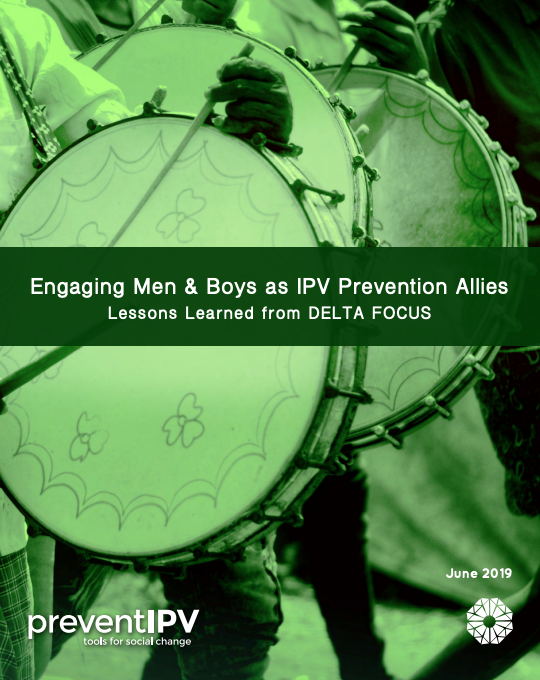Moving beyond the system of harmful gender norms that limits us and promotes inequality is a great challenge for many anti-violence programs. While doing the work of engaging men and boys, it is important to challenge the dominant stories of masculinities in our lives. These resources discuss the concept of bystander intervention, how to be an ally, and the idea of courageous conversations.
 Featured Resource: Engaging Men & Boys as IPV Prevention Allies: Lessons Learned from DELTA FOCUS
Featured Resource: Engaging Men & Boys as IPV Prevention Allies: Lessons Learned from DELTA FOCUS
The DELTA FOCUS (Domestic Violence Prevention Enhancement and Leadership Through Alliances, Focusing on Outcomes for Communities United with States) program supported domestic violence coalitions to identify, implement, and evaluate programs that are theoretically or empirically linked to reducing IPV, or decreasing risk factors or increasing protective factors for Intimate Partner Violence (IPV).
This story features lessons learned from three coalitions in Alaska, Ohio, and Rhode Island that implemented approaches to engage men and boys in IPV prevention: Alaska Men Choose Respect, Ohio Men’s Action Network (OHMAN), and Ten Men. The three coalitions’ approaches provide men a clear point of entry in the movement, an opportunity to establish a personal commitment to IPV prevention and concrete activities to help prevent IPV in their lives and communities. Their approaches focus on media messaging, social norms campaigns, networking/coalition work, peer support, mentorship, and skill building around leveraging community influence to impact change. Their experiences highlight the value of taking a learning approach in an area where there is limited information on potential barriers and facilitators to implementation.
 The PreventIPV Tools Inventory is a searchable collection of resources generated in the field includes training tools, campaigns, promising programs, evidence, policies, and other materials that can be adapted in your community to advance the prevention of intimate partner violence. It offers a wide array of prevention-focused tools, including materials on bystander intervention, engaging boys and men, and more!
The PreventIPV Tools Inventory is a searchable collection of resources generated in the field includes training tools, campaigns, promising programs, evidence, policies, and other materials that can be adapted in your community to advance the prevention of intimate partner violence. It offers a wide array of prevention-focused tools, including materials on bystander intervention, engaging boys and men, and more!
 Book of Dares: 100 Ways for Boys to be Kind, Bold, and Brave from A CALL TO MEN - "Society is in a moment of great transformation, with much focus on the evolution of masculinity. Parents of boys are confronted with terms like “toxic masculinity” and “male privilege” and the headlines are dominated with stories about men behaving badly. But being a boy is a wonderful thing... After 20 years of working with and educating men and boys, we know that healthy manhood is the solution. It’s the antidote for some of the most destructive problems in our society. We’ve turned pillars of healthy manhood into 100 dares that support boys’ authenticity and advance gender equity." And check out the accompanying Book of Dares discussion guide!
Book of Dares: 100 Ways for Boys to be Kind, Bold, and Brave from A CALL TO MEN - "Society is in a moment of great transformation, with much focus on the evolution of masculinity. Parents of boys are confronted with terms like “toxic masculinity” and “male privilege” and the headlines are dominated with stories about men behaving badly. But being a boy is a wonderful thing... After 20 years of working with and educating men and boys, we know that healthy manhood is the solution. It’s the antidote for some of the most destructive problems in our society. We’ve turned pillars of healthy manhood into 100 dares that support boys’ authenticity and advance gender equity." And check out the accompanying Book of Dares discussion guide!
"Parents and guardians who are traumatized or suffer from their own childhood trauma or emotional disturbances can struggle to be good role models for their youth because of their own maladaptive coping strategies. As a result, they can create environments where youth develop their harmful coping strategies that can be abusive later when they form friendships and intimate relationships. For boys, this can look like learning to cope with the violence of a parent by becoming violent themselves. Interrupting this cycle of trauma and abuse can be a good primary prevention strategy. For male-identified parents, this can be quite a journey." - Justin Carter
Check out the following resources and trainings, available for purchase:
"It is important to note while accountability is important, I think it carries an assumption about violence that it's a simple choice to or to not be violence. I think when all the risk factors are taken into account, violence looks more like a coping strategy that is learned by growing up in unsafe environments. This would mean that becoming nonviolent is more of a process and requires a similar approach to coping with trauma. We can't choose to be nonviolent any more than we can choose to not react to our triggers, but we can choose to begin the journey of learning what our triggers are and where they come from, and therefore better cope with them and heal. The shift in lens here is that we become accountable for choosing to heal our trauma that disposes us to violence as opposed to choosing not to be violent. This shift also allows us to see the structural and environmental features that we can address to reduce violence." - Armando Ruiz









